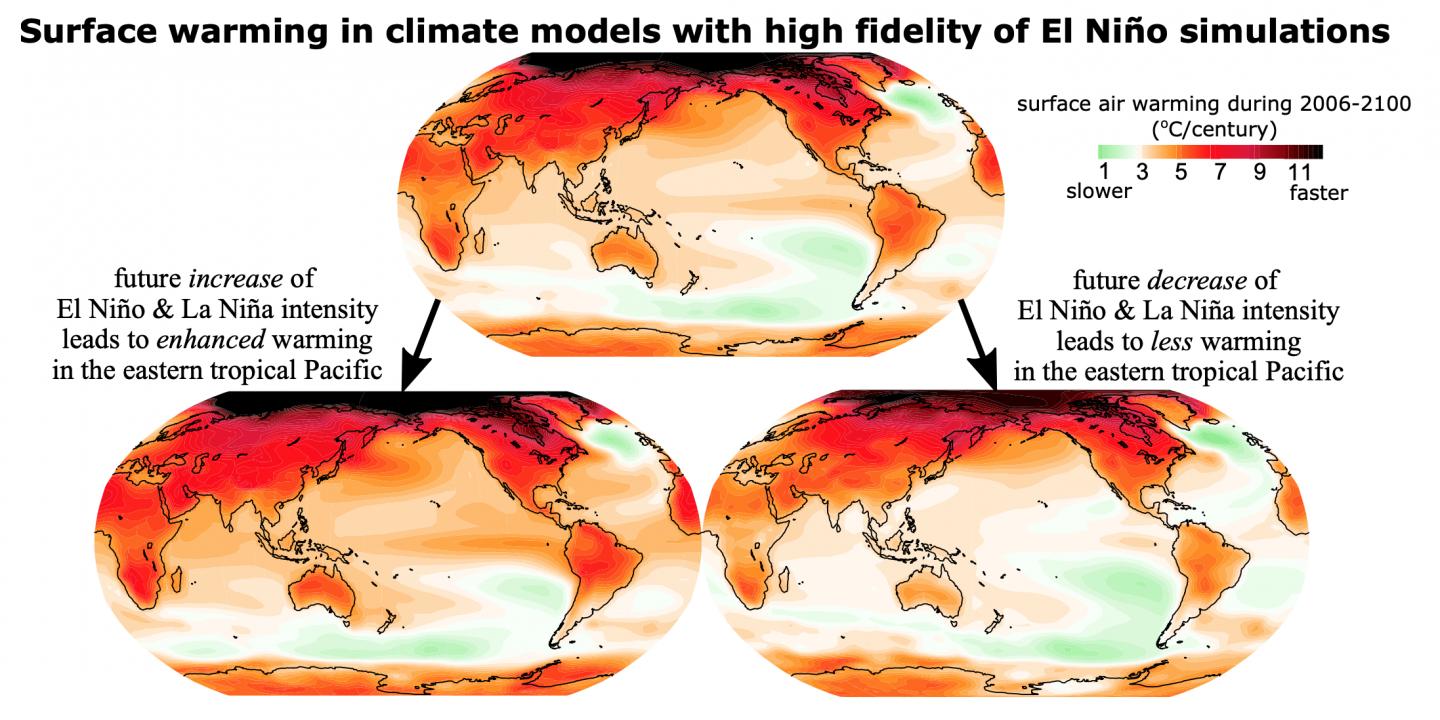Enhanced warming subtropical ocean is expanding the tropics
Tag: OCEANOGRAPHY
Choanozoan and picozoan marine protists are probably virus eaters – study
No other virus-eating organisms are known
Marine heatwaves like 2015’s Pacific “blob” attributable to anthropogenic climate warming
Severe marine heatwaves, like 2015’s Pacific “blob,” are far more likely to occur now than before human-induced global warming began, according to a new study. The findings underscore the importance of achieving ambitious climate goals to reduce the risks of…
Caribbean islands face loss of protection and biodiversity as seagrass loses terrain
Tropical islands have an important ally when it comes to battling storms and sea-level rise: seagrass. During hurricane Irma, an extremely powerful Category 5 storm that hit the North Caribbean in 2017, NIOZ scientist Rebecca James witnessed how native seagrass…
Stability check on Antarctica reveals high risk for long-term sea-level rise
The warmer it gets, the faster Antarctica loses ice – and much of it will then be gone forever. Consequences for the world’s coastal cities and cultural heritage sites would be detrimental, from London to Mumbai, and from New York…
New model — Antarctic ice loss expected to affect future climate change
UMass Amherst research simulates dramatic climate impacts from higher Antarctic melt
URI grad student finds PFAS in seabirds from Narragansett Bay, Massachusetts Bay, Cape Fear
KINGSTON, R.I. – Sept.23, 2020 – Evidence continues to accumulate about human and wildlife exposure to chemical compounds called per- and polyfluoroalkyl substances, collectively referred to as PFAS, and their deleterious effects on the environment. The latest study, by a…
Some polar bears in far north are getting short-term benefit from thinning ice
A small subpopulation of polar bears lives on what used to be thick, multiyear sea ice far above the Arctic Circle. The roughly 300 to 350 bears in Kane Basin, a frigid channel between Canada’s Ellesmere Island and Greenland, make…
Compounding impact of severe weather events fuels marine heatwave in the coastal ocean
Several coastal communities are picking up the pieces after being ravaged by hurricanes in the past month. Hurricane Laura, a category 4, and Hurricane Sally, a category 2, seemed to meander their way across the Gulf of Mexico constantly shifting…
Southern hemisphere could see up to 30% less rain at end of the century
Analysis published in Scientific Reports is based on climate models for the mid-Pliocene period, which occurred 3 million years ago and shared characteristics with present-day warming
40% of O’ahu, Hawai’i beaches could be lost by mid-century
The reactive and piecemeal approach historically used to manage beaches in Hawai’i has failed to protect them. If policies are not changed, as much as 40% of all beaches on O’ahu, Hawai’i could be lost before mid-century, according to a…
Undersea earthquakes shake up climate science
Despite climate change being most obvious to people as unseasonably warm winter days or melting glaciers, as much as 95 percent of the extra heat trapped on Earth by greenhouse gases is held in the world’s oceans. For that reason,…
Ocean acidification puts deep-sea coral reefs at risk of collapse
Deep-sea coral reefs face challenges as changes to ocean chemistry triggered by climate change may cause their foundations to become brittle, a study suggests. The underlying structures of the reefs – which are home to a multitude of aquatic life…
Noise from deep-sea earthquakes provides new way to measure ocean warming
Using soundwaves cast from seafloor earthquakes, researchers demonstrate a new take on a largely abandoned way to measure ocean warming worldwide – seismic ocean thermometry. The method, which they tested in the East Indian Ocean and where they uncovered a…
Understanding the movement patterns of free-swimming marine snails
New research relates shell shapes and body geometries and sizes with swimming abilities and sinking behaviors, which impact vertical migration and distribution.
How much will polar ice sheets add to sea level rise?
Over 99% of terrestrial ice is bound up in the ice sheets covering Antarctic and Greenland. Even partial melting of this ice due to climate change will significantly contribute to sea level rise. But how much exactly? For the first…
New estimates for the rise in sea levels due to ice sheet mass loss under climate change
An international consortium of researchers under the aegis of CMIP6 has calculated new estimates for the melting of Earth’s ice sheets due to greenhouse gas emissions and its impact on sea levels, showing that the ice sheets could together contribute…
Droughts in the Amazon rainforest can be predicted up to 18 months in advance
Monitoring surface temperatures in two regions of the Atlantic Ocean will reliably forecast droughts in South America.
Sea ice triggered the Little Ice Age, finds a new study
A new study finds a trigger for the Little Ice Age that cooled Europe from the 1300s through mid-1800s, and supports surprising model results suggesting that under the right conditions sudden climate changes can occur spontaneously, without external forcing. The…
Can pumping up cold water from deep within the ocean halt coral bleaching?
New research shows that pulses of cooler deep water reduced heat stress responses in corals
Marine animals live where ocean is most breathable, ranges may shrink with climate change
As oceans warm due to climate change, scientists are trying to predict how marine animals — from backboned fish to spineless jellyfish — will react. Laboratory experiments indicate that many could theoretically tolerate temperatures far higher than what they encounter…
Ocean algae get ‘coup de grace’ from viruses
Viruses don’t immediately kill algae but live in harmony with them
New research provides global analysis of storm surge footprints
New research provides a global analysis of the footprint of storm surges, providing a first step toward helping decision-makers coordinate flood management and emergency response plans across borders. When Category 4 Hurricane Laura made landfall, the biggest cause of alarm…
New shark research targets a nearly endangered species
NSU researchers lead team studying smooth hammerhead sharks
Ancient volcanoes once boosted ocean carbon, but humans are now far outpacing them
The closest analog to modern times is no longer very close, study finds
Shedding light on coral reefs
New research quantifies light availability on coral reef ecosystems
Unraveling 66 million years of climate history from ocean sediments
Based on extensive data analysis, an international team publishes global reference curve in the journal Science
66 million years of Earth’s climate uncovered from ocean sediments
Changes in the Earth’s climate over the last 66 million years have been revealed in unprecedented detail by a team involving UCL researchers, highlighting four distinctive climatic states
$500 billion question: what’s the value of studying the ocean’s biological carbon pump?
The ocean plays an invaluable role in capturing carbon dioxide (CO2) from the atmosphere, taking in somewhere between five to 12 gigatons (billion tons) annually. Due to limited research, scientists aren’t sure exactly how much carbon is captured and stored–or…
Poetry in motion: Engineers analyze the fluid physics of movement in marine snails
Results could inspire novel bio-inspired underwater vehicles
Ocean carbon uptake widely underestimated
The world’s oceans soak up more carbon than most scientific models suggest, according to new research. Previous estimates of the movement of carbon (known as “flux”) between the atmosphere and oceans have not accounted for temperature differences at the water’s…
FSU researchers track nutrient transport in the Gulf of Mexico
Researchers from Florida State University are shedding light on nutrient levels in the Gulf of Mexico with new findings published this month in the Journal of Geophysical Research – Oceans . The Gulf of Mexico receives considerable levels of nutrients…
The widespread footprint of blue jean microfibers
With many people working from home during the COVID-19 pandemic, blue jeans are a more popular wardrobe choice than ever. But most people don’t think about microscopic remnants of their comfy jeans and other clothing that are shed during laundering.…
Great Barrier Reef ‘glue’ at risk from ocean acidification
Study shows geologic ‘glue’ thickness is an accurate measure for historic pH levels
Monitoring and reporting framework to protect World Heritage Sites from invasive species
A team of international scientists have devised a new monitoring and reporting framework to help protect World Heritage Sites from almost 300 different invasive alien species globally including rats, cats and Argentine ants
Loggerhead turtles record a passing hurricane
In early June 2011, NOAA Fisheries researchers and colleagues placed satellite tags on 26 loggerhead sea turtles in the Mid-Atlantic Bight. The tagging was part of ongoing studies of loggerhead movements and behavior. The Mid-Atlantic Bight, off the U.S. East…
Revisiting ratios
A multinational study overturns a 130-year old assumption about seawater chemistry
Individual dolphin calls used to estimate population size and movement in the wild
Call of the wild: individual dolphin calls used to estimate population size and movement in the wild
Sea level rise from ice sheets track worst-case climate change scenario
Ice sheets in Greenland and Antarctica whose melting rates are rapidly increasing have raised the global sea level by 1.8cm since the 1990s, and are matching the Intergovernmental Panel on Climate Change’s worst-case climate warming scenarios. According to a new…
Humans’ construction ‘footprint’ on ocean quantified for first time
Scale of marine intrusion comparable to that on land

Fidelity of El Niño simulation matters for predicting future climate
A new study led by University of Hawai’i at Mānoa researchers, published in the journal Nature Communications this week, revealed that correctly simulating ocean current variations hundreds of feet below the ocean surface – the so-called Pacific Equatorial Undercurrent – during El Niño events is key in reducing the uncertainty of predictions of future warming in the eastern tropical Pacific.

New analysis reveals where marine heatwaves will intensify fastest
The world’s strongest ocean currents, which play key roles in fisheries and ocean ecosystems, will experience more intense marine heatwaves than the global average over coming decades, according to a paper published today in Nature Communications by researchers from the ARC Centre of Excellence for Climate Extremes at the University of Tasmania and CSIRO.
Fidelity of El Niño simulation matters for predicting future climate
A new study led by University of Hawai’i at Mānoa researchers, published in the journal Nature Communications this week, revealed that correctly simulating ocean current variations hundreds of feet below the ocean surface – the so-called Pacific Equatorial Undercurrent –…
A spatial regime shift to stickleback dominance
Large numbers of three-spined stickleback have gradually taken over larger parts of the Baltic Sea’s coastal ecosystem, shows a new scientific study. Stickleback is a small prey fish common in aquatic food webs across temperate Europe. The stickleback contributes to…
Ocean acidification causing coral ‘osteoporosis’ on iconic reefs
Scientists have long suspected that ocean acidification is affecting corals’ ability to build their skeletons, but it has been challenging to isolate its effect from that of simultaneous warming ocean temperatures, which also influence coral growth. New research from the…
New study warns: We have underestimated the pace at which the Arctic is melting
Temperatures in the Arctic Ocean between Canada, Russia and Europe are warming faster than researchers’ climate models have been able to predict.
Antarctic ice shelves vulnerable to sudden meltwater-driven fracturing, says study
Existing cracks could provide routes for disintegration, sea-level rise
How cold was the ice age? Researchers now know
Scientists’ ice age ‘hindcast’ may shed light on future climate
OU receives $20 million grant to lead National Science Foundation AI Institute
NORMAN, OKLA. – The University of Oklahoma is leading a National Science Foundation AI Institute for Research on Trustworthy AI in Weather, Climate, and Coastal Oceanography that is being hailed as a “historic milestone in environmental science.” NSF recently announced…
UBCO researcher uses computer modelling to predict reef health
‘Virtual’ coral reefs become diagnostic tool to help manage the planet’s reefs